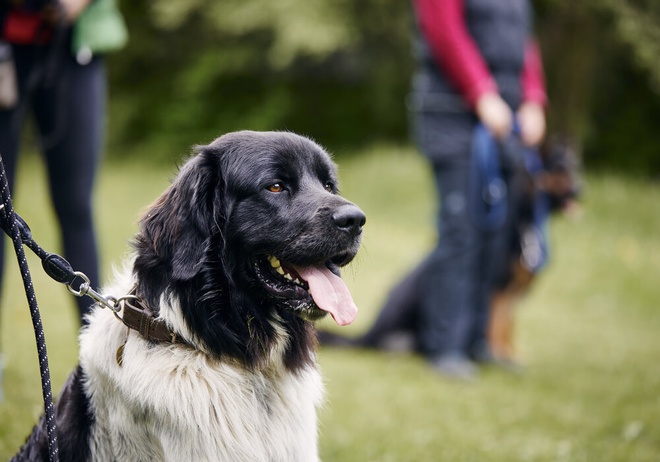How to train your dog with an electric collar?
Despite the controversy, electric collars remain a popular tool for many dog owners. But it is important to understand how to use them to avoid harming your pet dog. Find out in this article how to use them properly.

Reading time : 8 min
This type of dog training collar is undeniably divisive. There are dog owners who swear by its usefulness, and others who simply hate it. The defenders of animals are fiercely opposed to anything that could harm an animal in any way, the use of electric collars on dogs is no exception.
Other people simply denounce the abuses associated with electric collars. Some owners mistakenly believe that wearing an electric dog collar alone will solve a dog's behavioural problems. These days, training collars are used for anything and everything.
A dog training collar is not a miracle tool. To be effective, its use requires that the dog's owners not only rely on the object but that they be actors in the education of their dogs to obtain obedience.
TOPICS
What is a shock collar?

Definition of a shock collar
A shock collar, also called electric collar, is a tool used in dog training, sending small electric shocks or vibrations to the dog.
The handler must determine what to use it for as they serve two main purposes: it serves as an anti-bark collar, specially designed to teach the dog to stop barking, and it also serves for recalls, designed to help owners train their dog to return to recall and prevent runaways.
However, training collars have been misused to punish a dog that had an accident on the carpet or like to sleep on couches too often. The use of electric collars should be reasonable and sensible.
How much does a dog training collar cost?
There are many types of electric collars on the market, with prices ranging from around
for the cheapest to over
for the most efficient. It is very important not to rush into buying a training collar but to compare the features of each product.
Furthermore, even if it may be tempting to choose a low-end product, you must be aware that the functions will be limited and that some first price training collars may be poorly made.
For example, the electrical stimulation may be poorly dosed and may be painful or even dangerous for the pet. The range can be irregular, which distorts the distances between the owner and their dog.
How to choose the right training collar?
To make an informed choice and buy the best training collar for your dog, you should consider the different functions it has to offer. You should consider the exact use of the collar, your dog’s size, character, and nature, as well as the breed, as some breeds are known to be more dominant and stubborn than others. So, what should you take into account?
Weight
Some training collars are super-light, weighing 70g, while the heaviest ones can weigh over 500g. The weight is therefore a determining factor depending on the size of the dog.
A training collar for a small dog such as a Jack Russell will be quite different from a training collar for a large dog such as a Bernese Mountain Dog.
Range
A training collar has a range of a few metres to 400 or 600 metres.
Waterproofing
This is an option that most training collars have. Be aware, however, that while some models are waterproof and will follow dogs without problems when swimming in a stream, others are simply splash-proof.
This is an important point to bear in mind, depending on the dog's habits. For Labradors, which are known to love water, the collar must be truly waterproof and submersible.
Stimulation
Some training collars can emit vibrations and/or beep sounds, others deliver electric shocks, and some offer all three modes of stimulation.
The choice will depend on the dog's character. For example, an electric training collar should be reserved for a dog with a strong character or dominant tendency that cannot be tamed by a sound signal alone, whereas for other dogs, vibrations and beeps are more than enough.
Autonomy
This is an important criterion when choosing a training collar. Some training collars can have an autonomy of 50 to 70 hours. It is up to the dog owner to choose according to their preference as to the charging method.
There are training collars with a battery that can be recharged in 2 or 3 hours at most, but which have the disadvantage of having to remove the collar from the dog for a few hours.
Emergency system
Some collars have an emergency system that is used in case of an escape or an impromptu attack. This type of system should only be used in cases of force majeure, as it consists of sending a stronger shock and therefore hurting and stopping the pet.
Finally, some training collars are designed to work simultaneously with several dogs. A single remote control governs several collars, which is ideal for an owner with multiple dogs or a hunter.
How to use a dog training collar?

Warning before use
Temporary device
You should keep in mind that training collars are not magical tools, but an object used in conjunction with the more traditional education of the dog.
Its use must be temporary and in no way replaces the education of the dog by the owner. Owners must truly be an actor and learn to educate their dog with kindness and consistency.
The training collar must not be used to systematically make the dog obey but rather to teach the dog precise commands. Furthermore, its use should be no longer useful once the dog understands what their owner expects.
Not to be used on all dogs
Training a puppy is certainly not done with an electric shock collar. The training collar is not suitable for a puppy under 8 months old, a dog with a heart condition or a pregnant female.
Such a device should be used with a healthy, trained dog that is already familiar with basic commands. Training sessions with the dog training collar should not exceed 10 to 15 minutes and the collar should be removed as soon as the training sessions are over.
How to start with an electric dog collar?
The recall collar, however, requires to be hands-on. In any case, for both types of collars, it is important to respect a familiarisation and adaptation period of one to two weeks with the training collar.
During this period, the collar will be placed around the dog's neck for some time, but no stimulation should be delivered.
Furthermore, even if most recall collars offer several levels of stimulation, you should never use them all. The aim is to make your dog obey you, not to hurt them. The aim is to find the lowest level to which the dog responds.
Therefore, training should always start with the lowest level of stimulation. If the dog does not respond, the intensity of the stimulation should be increased until the dog is receptive. The adjustment is made over time.
How to use a shock collar for dog training
During off-leash walks, if the dog does not respond to the recall or refuses to return:
- The owner should use the sound signal mode to warn the dog.
- If the dog continues to wander away or is too distracted by the environment to obey, the owner should use the vibration mode as a second warning.
- If the dog refuses again after the first two warnings, the owner should then use the electric shock at a low level of intensity initially and then increase the intensity until the dog is receptive.
Of course, these instructions should be adapted according to the model of the dog training collar and the stimulation functions it offers.
But if these steps are followed, the dog should revise their behaviour over the course of the day and if they are particularly receptive, sometimes only the sound function is needed. In any case, the owner should not forget to reward the dog with treats, petting and even praise as soon as they return.
10 questions to test your pet training knowledge
Do you know everything there is to know about training dogs and cats? Answer our 10 questions to find out!
What are the limits to training collars?
Doubts about its long-term effectiveness
Training collars rely on negative reinforcement, so the dog corrects their behaviour to avoid facing punishment. However, training collars should be used only temporarily.
Thus, there is a question as to whether the dog's bad behaviours and urges may reappear once the use of the training collar is stopped.
Stimulates negative association
Furthermore, if the training collar is used to calm a dog that is overly aggressive towards a person or other dog, the dog will associate the presence of that person or other dog with a negative experience if it is stimulated.
What will happen when the dog encounters the person or other dog while not wearing the training collar?
Affects the relationship between the dog and the owner
Similarly, if the use of the training collar is exclusively for punitive purposes, the dog may be led to believe that they have done something wrong when the collar is put on when only the owner is acting in anticipation. What impact does this have on the relationship and trust between dog and owner?
Nervousness, aggression, lethargy, and compulsive licking are all behavioural problems that can occur as a result of the overuse of electric collars. Other dog training methods or educational aids based on positive education preserve the relationship between dog and owner.
Many behaviourists and dog trainers have turned to these training techniques in recent years. Cooperative training allows the relationship to be reinforced while teaching the dog the desired behaviour. The trust and the complicity are not affected.
Cat training collars
We have deliberately not mentioned cat training collars in this article, for the simple reason that a cat cannot stand such treatment.
Owners who would risk attaching an electric cat collar to their pet would see their cat run away at the first opportunity to find a new home that is safer, more peaceful and, above all, where their freedom will not be questioned.
How to train a kitten? How to train a cat? Read more about the proper ways to train a cat in this article.
What are some alternatives to electric collars?
The training spray collar
There are options other than the electric shock collar for training your dog. The training spray collar, unlike other training collars, would be closer to gentler training methods.
It consists of a spray can attached to a dog collar. It is generally used to stop a dog's barking. When the dog barks, it is sprayed with citronella at nose level.
Why citronella? Because, like lemon, it is a smell that dogs do not like very much. That said, with water or diluted lemon juice, it works just as well. The aim is to startle and annoy the dog to stop their inappropriate behaviour, not to harm them.
The ultrasound training collar
Like the spray collar, the ultrasound training collar is another option for stopping incessant barking. Unlike humans, dogs can hear ultrasound. Ultrasound is triggered as soon as barking is heard. Some dogs that are sensitive to ultrasound will be surprised and stop barking; others will not be vulnerable at all.
In other words, the effectiveness of the ultrasound collar is relative to the dog's level of sensitivity.
The GPS tracker
GPS trackers for dogs and GPS trackers for cats are not strictly speaking used for training dogs or cats. They do, however, allow the pet's position to be tracked in real-time, without any distance limits.
The owner also has the possibility of defining a perimeter for the dog and cat, the garden for example. If the pet crosses the perimeter, a notification is sent directly to the smartphone. The owner is then able to know the position of the dog or cat immediately and to recover them quickly.
Finally, some GPS collars offer a recall option. The idea is simply to condition the pet at mealtimes by ringing or vibrating their GPS collar from the smartphone. This way, the cat and dog will associate the vibration of their collar with their meal and will easily return home.
Conclusion
The training collar does not always get a good press and with the use of positive reinforcement in dog training, it is becoming increasingly controversial. However, there are now many different types of training collars: electric, vibration, sound, but also spray or ultrasound training collars considered less intrusive for the dog.
The fact remains that the use of such dog training collars must be extremely well thought out and combined with more conventional training. They require a good grip from the master as well as a period of familiarisation for the dog initially trained and used to basic commands.
Continue reading our guide
This article is a part of a complete guide on the subject. Do not miss the next chapters.
Do you know everything there is to know about training pets?
Answer our 10 questions to test your pet training knowledge.


